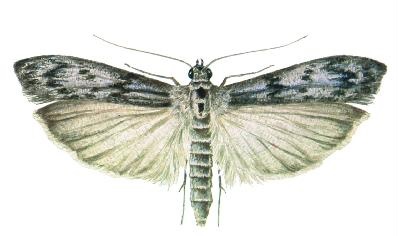Moths in groceries

Indian meal moth and Mediterranean flour moths are pests in groceries. Warehouse moth (Ephestia elutella) and Almond moth (Ephestia/Cadra caudella) have also been located in Finland, but very seldom they cause significant damage.
Indian meal moth (Ephestia kühniella) is however one of the worst pests in bakeries and mills. In households, their flying adults can also cause problems. They are very often considered as clothing moths.
Larvae of Indian meal moth is very common in mills and bakeries. There it is mostly located in wheat flours. They have never been found in grains. Larvae creates ropes, which looks like spider nest. It causes flour getting thick. That thickness includes a lot of their feces. Do you want to eat it? Adult moth do not eat anything. It just flies at night. During daytime, it just sits somewhere in dark and shadowy places with its wings closed. Moths cope winter conditions quite well. Shortly -15°C.
Indian meal moth (Plodia interpunctella) makes dry products dirty with its dropping and feces.
It is also a real pest at dry fruit production facilities in sunbelt countries. It came to Finland together with imported products (e.g., dried fruits, almonds, nuts and sweets). Also their larvae creates ropes, which looks like spider nest. They spread very easily. Indian meal moth cannot cope Finnish winter in cold storages.

Identification
Adult Mediterranean flour moth lenght (wings) is 2 cm. Front wings are grey and they contain dark “criss-cross” patters. Their larvae are also 2 cm but quite blond, soft and bald (not very hairy). Dark spot can be also found from its back. That spot is not visible with indian meal moth larvae.

Adult Mediterranean flour moth lenght (wings) is 1,5 cm. Front wings are both light-grey and read. Their larvae are also 1,5 cm but quite blond, soft and bald (not very hairy).


What can I do by myself?
Mediterranean flour moth pest control can be a challenging task, because its larvaes can easily spread along with the wheat dust. Because it is not an easy task to use insecticides in mills and bakeries, continuous monitoring is vital. Regular check-ups as well as the maintenance (cleaning) of production facilities and machines is also vital. Keep the indoor temperature of your production and storage facilities as low as possible.
Indian meal moth sensitive products e.g., almonds, nuts and raisins, shall be put to freeze (-25-30°C). Pest control is challenging if you do not spot the problem early. Heavily infested products needs to be junked – lowly infested products can be saved by freezing. Infested facilities needs to be handled by professionals. Please contact us.
If you cannot control flour moth problem by yourself, please contact us. We will solve it!

Pest control of textile moths
First, the situation is analysed and an individual prevention plan is drawn up for the site. This is followed by an effective and high-quality pesticide treatment.
We use a variety of methods to achieve the best possible results as quickly as possible. We also try to avoid the use of biocides as much as possible.
For more information on the prevention methods we use, please contact our professional pest controllers. Contact us!

